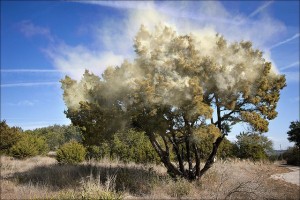How Hill Country Grazing Led to Cedar Fever in Texas

Photo courtesy of Flickr/flickr.com/23959586@N00/
Looking for someone to blame for cedar fever? Try your ancestors.
This story originally ran in 2013, but judging from the tickle in our throats, it seems appropriate to post again.
Your Grandpa’s Cheeseburger Might Be Making You Sneeze
For many Texans, ‘Cedar Fever’ has its own place in the region’s pantheon of demons, alongside the likes of the Chupacabra, Yolanda Saldivar, and chili with beans. If you’re one of those Texans, the onset of winter, when male mountain cedar plants release their pollen and set the world a-sneezin’, is cause for dread.
It is not unheard of for mountain cedar pollen to amass in the air and create a haze in the Hill Country sky. We’ve been conditioned to look upon a cloud of pollen with unease, but this does little to explain the link between pollen and ‘Cedar Fever.’ Just what is it about this speck of plant material that brings misery to some people? More importantly, how did it become so problematic in Central Texas?
Dr. Edward Brooks researches allergy at the UT Health Science Center in San Antonio. While admitting that establishing true causality for cedar pollen allergy is “scientifically tricky,” he reveals that scientists have identified certain correlations that suggest some explanation. So far, it appears that incidence of allergy is determined by several factors coming together: an individual’s genetics, the structure of the pollen grain, and how much of that pollen is around. And one of the key factors for that last one is the result of specific land use and management practices by Texans in the late 19th century. If you want to blame someone for cedar fever, you could start with them.

Photo by Daniel Ramirez
A sign outside a Northside San Antonio allergy clinic urges 'cedar fever' victims to seek relief.
The Edwards Plateau, the technical name for the Texas Hill Country, is an island of hills in the ocean of the Great Plains. Even though it is an outlier with its uneven topography, it is still part of the grassland environment that comprises the Plains. As such, before Texans began settling the area, the rolling upper areas would have been extensive prairies punctuated by occasional oak trees. More precisely, it would have been an oakland savanna.
The steeper slopes and ravines, on the other hand, would have been the natural habitat of the ashe juniper, the scientific name for mountain cedar. Native to the area, ashe juniper is specifically adapted to rocky areas, something seen in abundance along the steep limestone hillsides of the Hill Country.
Grasses are ideal plants for our variable climate – too dry for an extensive forest, and not dry enough for a desert. Its deep root system keeps it alive underground even while dry weather, fire, and grazers reduce it above ground. Take away such pressures and add a good rain, and grass is primed for regeneration. In fact, it was such a characteristic that led Indians of the Great Plains to set fire to dry grass to attract bison with new, green growth.

Photo courtesy of UTSA
Oscar Van Auken says the grazing habits of European immigrants have made cedar fever much worse than it would have been otherwise.
But when Europeans moved into the area, grass steadily declined in exchange for juniper scrubland. Grassland Ecologist at the University of Texas at San Antonio, Dr. Oscar Van Auken, sums up the process in a 2008 study: “The prime cause of the current and recent encroachment [of woody shrubs like juniper] appears to be high and constant levels of grass herbivory by domestic animals.” That’s fancy science talk to say that cattle, sheep — and now goats — in the Hill Country have steadily eaten up all the grass, eliminating juniper’s competition in the area.
Domestic grazers have existed in the area since the Spanish brought cattle and sheep, letting them loose on the plains. These animals were not adapted to the land in quite the same way that native bison were, who foraged efficiently and aerated the soil with their pointy hooves as they went.
The process of juniper overgrowth really accelerated, though, when the invention of barbed wire provided an efficient method for fencing in the open range near the end of the 19th century. The concurrent expansion of the railroads meant better connection with markets to the north and east. Ranchers kept up with increasing national demand for meat by ramping up growing operations. Penning in cattle allowed for a denser product inventory.
Their movement now restricted, the grazers could not seek out the next plot of healthy grass and allow the one they came from to regrow. Meanwhile, they left the unpalatable juniper shoots intact. As the process snowballed, any new grass growth was gobbled up while those juniper shoots became juniper bushes.
Other processes contributed to the problem. American settlers weren’t keen on fire the same way that Indians or nature (in the form of lightning) was; they tried to suppress it when possible. Since fire killed juniper but not grass, suppressing fire may have contributed to overgrowth at first, but Van Auken explains that fire became less prevalent regardless. That’s because as domestic grazers ate up all the grass, including the dry stuff, fire no longer had good kindling to burn.
The process was exacerbated by erosion. Grass roots were good at holding the soil in place. Without this anchor in place, the soil eroded whenever a heavy rain came. The rocky substrate that was uncovered was just fine for juniper plants that were adapted to such soils.

Photo by Jeff Jeter/Wikimedia Commons
In this typical Hill Country vista, like this one at Garner State Park near Uvalde, evergreen shrubs have replaced grassland.
However, Van Auken warns that focus on erosion shouldn’t cause one to lose sight of the main agent of change: lots and lots of animals eating up the grass only to leave behind the juniper shrub. But before you go and blame the cows, sheep, and goats for our current woes, remember that it was human demand for products like leather, wool, and especially meat that put them there in the first place.
This process wasn’t uniform across the area, but happened piecemeal. Over the course of a century, however, it has completely changed the character of the Hill Country landscape. Now, when one travels to the area, vistas are filled with hillsides choked by evergreen shrub. It’s not necessarily an eyesore, but it is an ecosystem lacking in previous diversity, a little less in balance. Moreover, a tree that was always native to the area now exists at a density that’s made many of us miserable.

Photo courtesy of UT Health Science Center
Dr. Edward Brooks says air pollution may worsen allergies.
This effect of human agency foreshadows an even greater incidence of allergy as we continue shaping our environment. Dr. Brooks at the UT Health Science Center explains that there is evidence that air pollution can increase allergy prevalence. Some studies have shown that “people that live near roadsides,” he says, “have a higher rate of allergy.” The fine particulate matter from automobile exhaust is the likely culprit. Though it’s uncertain whether the pollution affects the plant itself or the health of the individuals nearby, Brooks suspects the latter.
That doesn’t mean that outside forces can’t affect a plant’s production of pollen. Researchers are currently exploring the role that stressors – drought, disease, etc. – play in the manufacture of allergens. “[I]n some cases,” Brooks says, “heat and drought help the production of certain allergenic pollens.”
This question has substantial implications for a warming Texas, in which heat and drought are expected to increase. “A lot of people are talking about what effect global warming will have on allergy in general,” Brooks adds. It may be conjecture as of yet, but there’s a haze of evidence around us connecting our past actions with our present maladies.